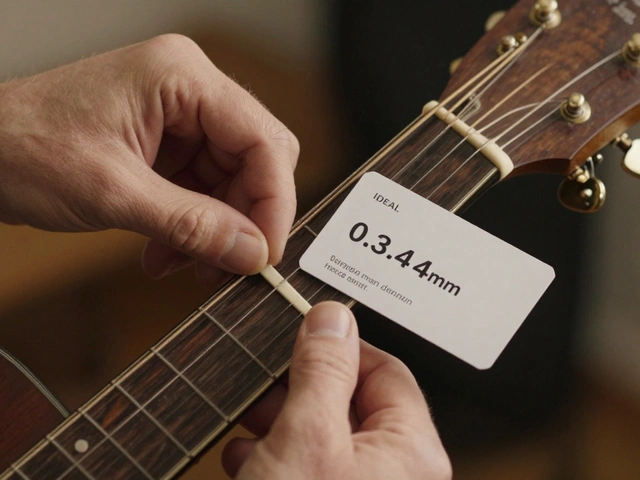Strumming Patterns and Rhythm Mastery
Mastering strumming patterns and understanding rhythm is the backbone of excellent acoustic guitar playing. Whether you’re just beginning or have been playing for years, the key to captivating your audience lies in the rhythm. It's not just about striking the strings; it's about making each note count, setting the pace, and driving emotion through your music. There's a vast array of strumming techniques, from the basic down-and-up strum to more complex patterns that involve muted strums and syncopation. A diverse skill set in strumming allows you to play a broader range of musical styles and gives your performances a more dynamic and expressive quality.
It's essential to start with the basics. Practice your timing and aim to keep a consistent pace. A metronome can be an invaluable tool here, helping you maintain a steady beat. As you grow more comfortable, begin to incorporate different strumming patterns into your practice sessions. Listen closely to songs you enjoy and try to identify the patterns used, then replicate them with your guitar. This not only improves your strumming ability but also enhances your listening skills and musical intuition.
One fascinating aspect of rhythm guitar is the variety it can bring to a song. Even with the same chords, altering the strumming pattern can completely change the song's feel. This is why rhythm mastery is so critical; it's the foundation upon which melodies and harmonies are built. Experimenting with different rhythms and patterns not only boosts your creativity but also expands your repertoire, helping you adapt to various genres like folk, rock, country, and blues. It's a skill that serves as both the groundwork and the embellishment of your playing.
Fingerpicking Techniques
Fingerpicking is a technique that can significantly enrich your acoustic guitar playing. It involves plucking the strings directly with your fingertips, nails, or picks attached to your fingers, allowing for a more intimate and intricate approach to guitar playing. This technique offers a level of control and subtlety not easily achieved with a pick, enabling you to bring out delicate nuances and dynamics in your music. Fingerstyle guitar playing is particularly popular in genres like folk, classical, and blues, where expressiveness and detail are paramount.
There are several key patterns in fingerpicking that form the basis of this technique. The thumb plays a pivotal role, often responsible for the bass notes, while the index, middle, and ring fingers pluck the melody lines or chordal harmonies. Practicing these foundational patterns is crucial as they provide the building blocks for more complex and varied fingerpicking styles. By developing finger independence and strength, you'll find it easier to navigate across strings smoothly and with precision.
One effective way to hone your fingerpicking skills is to start with simple patterns and gradually increase complexity. Begin by alternating bass notes with your thumb while plucking a steady rhythm with your other fingers. As you become more comfortable, incorporate melody lines and chord transitions into your practice. It's also beneficial to learn from the masters; studying the works of renowned fingerstyle guitarists such as Chet Atkins, Merle Travis, and Tommy Emmanuel can offer invaluable insights and inspiration. Pay attention to their technique, choice of patterns, and how they express emotion through their playing. By emulating and adapting their styles, you can develop a unique fingerpicking voice of your own.
Advanced Techniques: Hammer-Ons, Pull-Offs, and Slides
Once you have a good grasp of strumming and fingerpicking, it's time to explore more advanced guitar techniques like hammer-ons, pull-offs, and slides. These techniques add flair and sophistication to your playing, enabling you to execute fast runs, intricate melodies, and soulful solos with ease. Hammer-ons involve quickly pressing down on a fret immediately after plucking a string, creating a smooth transition between notes. Pull-offs are the opposite; by plucking a fretted note and then swiftly lifting your finger off the fretboard, you allow the string to resonate to a lower note.
Slides, on the other hand, consist of striking a note and then smoothly sliding your finger up or down the fretboard to another note. These techniques not only embellish your playing but also enhance legato (smooth and connected) phrasing, making your music sound more fluid and expressive. To effectively incorporate these techniques into your playing, start slow and focus on precision. Practice them in isolation first, then within the context of scales, melodies, and ultimately, songs. It's also crucial to pay attention to your hand and finger positioning to ensure smooth transitions and clean execution.
Many iconic acoustic guitar pieces showcase these advanced techniques, offering excellent learning material. For instance, the hammer-ons and pull-offs used in Led Zeppelin’s 'Stairway to Heaven' or the emotive slides in Pink Floyd’s 'Wish You Were Here' are classic examples that highlight the power of these techniques. By studying and practicing these songs, you can gain a deeper understanding of how to apply hammer-ons, pull-offs, and slides creatively in your playing.
Incorporating These Techniques into Your Practice Routine
Learning new guitar techniques is exciting, but it can also feel overwhelming. The key to mastering them is consistent practice and patience. Incorporate the techniques you’ve learned into your daily practice routine, dedicating time to each one. Begin with the basics, gradually building up complexity as you become more confident. It’s crucial to practice with intention, focusing on areas that need improvement while also challenging yourself with new exercises and songs.
Set realistic goals for yourself, such as mastering a new strumming pattern, perfecting a fingerpicking song, or incorporating advanced techniques into a solo piece. Celebrate your progress, no matter how small, and remember that every guitarist, even the most accomplished ones, was once a beginner. Learning from mistakes and persisting through challenges are part of the journey to becoming a skilled guitarist.
Finally, don’t hesitate to seek feedback from more experienced players or teachers. They can offer invaluable advice, spot issues you may not notice, and guide you through difficult techniques. Engaging with the guitar community, whether online or in person, can also provide support, inspiration, and opportunities to share your music. By dedicating yourself to practice and embracing the continuous learning process, you’ll not only master these essential acoustic guitar techniques but also discover your unique musical voice.






